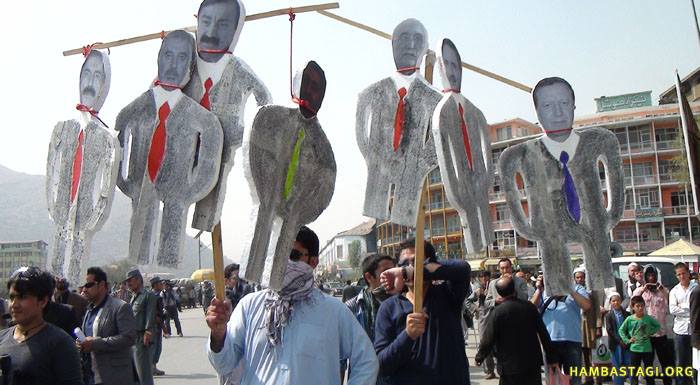Afghans have begun two days of mourning for victims of the communist government in the late 1970s. It was prompted by a list naming 5,000 people who were killed or disappeared in that time. Many were conservative opponents of the government which seized power in April 1978 - a year before the Soviet invasion. The BBC's David Loyn reports from Kabul.
Zamir Mihanpoor was inseparable from his brother Khwarja.
"He was not only my brother, he was my friend," he said, his voice thick with emotion.
Khwarja, 26, was among 5,000 people whose names have emerged on a list of those killed by the communist government in Afghanistan in the 18 months before the Soviet invasion at Christmas 1979. They will be remembered in two days of national mourning on 30 September and 1 October.
Khwarja was a teacher, but was also politically active in the Parcham wing of the Afghan communist movement. He was arrested when the rival Khalq faction seized power in April 1978 in the so-called Saur Revolution - named for the month in the Afghan calendar when it happened.
His brother Zamir said that he heard from two of Khwarja's cellmates that the young teacher was badly beaten every day, to the point that he could hardly drink water when he was thrown back in the cell in the evenings. One day, he did not return from the beatings.
War crimes

The New York Times, Oct. 1, 2013: One particular target of popular anger is Assadullah Sarwari (left), Mr. Osman’s boss at the Afghan intelligence agency in 1979, who was initially sentenced to death but later had his sentence reduced to a 19-year prison term.
Another former official who is frequently mentioned is retired Gen. Abdul Wahid Taqat, who headed the intelligence services under the last Afghan Communist government. General Taqat called the publication of the lists a plot against him to thwart his own presidential aspirations.
The list of 5,000 names emerged in the hands of an Afghan now living in Germany. It was among evidence collected as part of a war crimes trial in the Netherlands for a former Afghan intelligence officer, Amanullah Osman, who had originally claimed political asylum.
The list was released by the court, who thought it ought to be made public after Comm Osman died.
In the confusion of the times, one of those on the list, Habib Rahman, an engineer, is still alive. He is now a businessman in Kabul, but saw his name at number 2676 on the list. For months, he said that he and other prisoners in Pul-e-Charkhi jail lived "each day as if it was the last".
After the cell doors were locked at night, 10 or 15 names would be read out, and people led out to be shot.
"Everybody was thinking that tomorrow night it might be me," he said.
But although the list showed that his execution was ordered, he was never called out. Days after the Russian invasion, a knife was cut through the plastic sheeting that kept the weather from their cell, a blond head appeared, and a Russian soldier greeted them warmly. Days later, they were freed.
Scores dead
Mr Rahman went to the Ministry of Interior in January 1980 to see thousands of people lining up in front of boards listing names of those killed by the regime that preceded the Soviet-backed government.
The list of 5,000 names published by the Dutch court is about half of the list announced then, and a small fraction of the total number of perhaps 50,000 killed in the year before the Soviet invasion.
A million more would die in the years that followed at the hands of the Soviet forces, their Afghan followers, the mujahideen who opposed them, and later the Taliban.
Last Friday, an event described as a "mass funeral and memorial for those martyrs without graves" was held on open ground in central Kabul. Men wept openly during speeches and prayers, and photos of the dead were propped up on chairs in front of a stage.
Many of the speakers called for trials for the crimes of the communists. And research by the Afghanistan Independent Human Rights Commission showed that there is a widespread desire for reparations to be made for the past, and for those responsible for killings to be brought to justice.
The cruelty of the Taliban is well-known in the West, although the focus groups questioned for this research were more concerned about the crimes of the communists and later the mujahideen, who fought among themselves after the fall of the Soviet-backed government in Kabul in 1992.
On a recent visit to Kabul, the UN high commissioner for human rights said: "I would back investigations, prosecutions and trials."
But despite a groundswell in opinion that there should be trials for the crimes of the past, former warlords rely on an amnesty law passed in parliament, and many remain in powerful positions, not challenged by Nato forces in Afghanistan.

Sep. 29, 2013: Protestors of the Solidarity Party of Afghanistan hold hung dummies of the high-ranking Soviet puppet regime officials. From left to right: Shahnawaz Tanai, Asadullah Sarwari, Said Mohammad Gulabzoy, General Waahid Taqat, Dastagir Panjsheri, Noorulhaq Uloomi and Kabir Ranjbar. (Photo: Hambastagi.org)
More Photos



